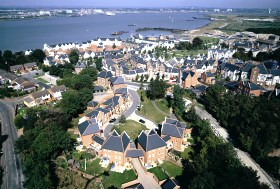History of Kent Thameside
The need for Fastrack is intrinsically linked with major regeneration of the area that is already happening and will continue for many years to come.
The story of Kent Thameside can be traced back to the publication of Government regional planning guidance in 1995 (Thames Gateway Planning Framework Regional Planning Guidance RPG9a).
The Thames Gateway became a national focal point for regeneration and growth, and Kent Thameside in particular was identified as ‘a growth area of regional significance’. The original Kent Thameside Vision document “Looking to the Future”, published in Autumn 1995, set out a long-term vision for the regeneration of the area.
A bold strategy for sustainable mixed-used development set in a high quality environment and integrated with existing communities was proposed for Kent Thameside. Although the strategy has been under continuous development and refinement since first published, the fundamentals have stood the test of time and continue to inspire and drive regeneration and development across Kent Thameside.
The key objectives of the strategy are:
- Build up to 25,000 new homes
- Achieve a significant shift from car use to use public transport
- Create an extensive framework of attractive open spaces
- Develop sustainable communities
- Promote town centre renaissance
- Deliver up to 50,000 new job opportunities
- Develop over 15 million square feet of new commercial buildings
- Achieve the highest quality standards
- Embrace ‘Life-Long Learning’
The Kent Thameside Regeneration Partnership brought together public and private sector interests to drive forward regeneration projects including Fastrack. The Kent Thameside Regeneration partnership ceased operation on the 31 March 2011. The regeneration of Kent Thameside and the wider Thames Gateway remain high on the local and national agenda.
Fastrack will be seen to play a key role in the new Paramount Park development. Paramount Park development website.









